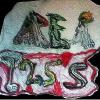H2S keeps looking more interesting.
Mol Neurobiol. 2015 May 28. [Epub ahead of print]
Hydrogen Sulfide Ameliorates Homocysteine-Induced Alzheimer's Disease-Like Pathology, Blood-Brain Barrier Disruption, and Synaptic Disorder.
Kamat PK1, Kyles P, Kalani A, Tyagi N.
Elevated plasma total homocysteine (Hcy) level is associated with an increased risk of Alzheimer's disease (AD). During transsulfuration pathways, Hcy is metabolized into hydrogen sulfide (H2S), which is a synaptic modulator, as well as a neuro-protective agent. However, the role of hydrogen sulfide, as well as N-methyl-D-aspartate receptor (NMDAR) activation, in hyperhomocysteinemia (HHcy) induced blood-brain barrier (BBB) disruption and synaptic dysfunction, leading to AD pathology is not clear. Therefore, we hypothesized that the inhibition of neuronal NMDA-R by H2S and MK801 mitigate the Hcy-induced BBB disruption and synapse dysfunction, in part by decreasing neuronal matrix degradation. Hcy intracerebral (IC) treatment significantly impaired cerebral blood flow (CBF), and cerebral circulation and memory function. Hcy treatment also decreases the expression of cystathionine-β-synthase (CBS) and cystathionine-γ-lyase (CSE) in the brain along with increased expression of NMDA-R (NR1) and synaptosomal Ca2+ indicating excitotoxicity. Additionally, we found that Hcy treatment increased protein and mRNA expression of intracellular adhesion molecule 1 (ICAM-1), matrix metalloproteinase (MMP)-2, and MMP-9 and also increased MMP-2 and MMP-9 activity in the brain. The increased expression of ICAM-1, glial fibrillary acidic protein (GFAP), and the decreased expression of vascular endothelial (VE)-cadherin and claudin-5 indicates BBB disruption and vascular inflammation. Moreover, we also found decreased expression of microtubule-associated protein 2 (MAP-2), postsynaptic density protein 95 (PSD-95), synapse-associated protein 97 (SAP-97), synaptosomal-associated protein 25 (SNAP-25), synaptophysin, and brain-derived neurotrophic factor (BDNF) showing synapse dysfunction in the hippocampus. Furthermore, NaHS and MK801 treatment ameliorates BBB disruption, CBF, and synapse functions in the mice brain. These results demonstrate a neuro-protective effect of H2S over Hcy-induced cerebrovascular pathology through the NMDA receptor. Our present study clearly signifies the therapeutic ramifications of H2S for cerebrovascular diseases such as Alzheimer's disease.
PMID: 26019015




















































